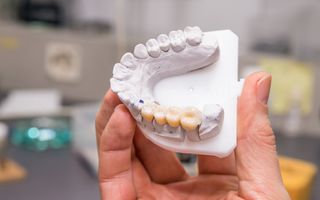
Dental Bridge
Bridging the gap with a bright, healthy smile.
With Richmond Fine Dentistry, Melbourne has a dentist it can trust for professional and high quality dental bridges.
What are dental bridges?

A dental bridge is a prosthetic device that ‘bridges’ the gap caused by missing teeth. It is still one of the most popular and efficient ways of replacing missing teeth. A bridge is secured by crowns attached to carefully prepared natural teeth on either side of the space and fills the area with a high quality porcelain prosthetic replacement, restoring your smile, confidence and function.
What Is the problem with missing teeth?
If you are missing one or several teeth, there are many associated oral and general health problems that can develop. When you have missing teeth, it is possible for your adjacent teeth to encroach into the vacant space and your opposing teeth to move out of alignment, allowing spaces between otherwise perfectly aligned teeth to occur and thereby become crooked and hard to clean effectively. This will significantly increase your risk of developing gum disease and jaw alignment problems which can result in headaches, neck and shoulder pain.
Dental bridge procedure
The procedure for a bridge closely resembles that for a single crown. Your supportive teeth, to which the crowns are bonded, are precisely reshaped so when your crowns and bridge is secured in place, they blend seamlessly in size and appearance with your surrounding natural teeth.
Once prepared, a detailed impression mould is made of your teeth and gum-line, this is used as a template from which your replacement bridge is sculpted. While your new bridge is being made at a dental laboratory, a temporary bridge may be worn, this will enable you to retain your full smile appearance.
When your new permanent bridge is complete and returned from the laboratory, your Richmond Fine Dentistry dentist will remove the temporary bridge replacing it with your new bridge so you can have a new healthy, natural looking smile.
All general practitioner dentists are qualified to fit dental crowns and bridges. Appropriate treatment is based on your dental and medical history, x-ray examinations of your teeth and jaws, and an oral examination. Appointment times will vary especially in the event that a tooth may need a root canal filling and perhaps a post, before crown or bridge treatment.
What are dental bridges made of?
Dental bridges are usually made of porcelain and gold alloy. Porcelain is strong and stain resistant and can be made to match the colour of your natural teeth. Gold alloy is used for its strength, hardness and durability. Both porcelain and gold alloy are well tolerated by gum and cheek tissue, so allergic reactions are rare.
Contact us today for more information or to book an appointment for your dental bridges in Melbourne.
Frequently asked questions
Dental bridges should last for many years; however there is no lifetime guarantee. As with natural teeth, it depends on good dental hygiene and oral health. Therefore, regular dental check ups are advisable.
Dental crowns require flossing and brushing, with extra attention around the margins where decay is more likely. Special devices include floss threaders and “superfloss” is available for cleaning under the bridge.
Usually, a bridge replaces just one tooth, but it can replace up to four teeth. It can depend on your oral health and the placement of the gap, so be sure to ask your dentist for the best options.
Dental bridges are quite safe with few side effects, but there are some possibilities to be aware of. These include swelling and pain around the site following each procedure, infection, potential nerve damage, and breakages or slips of the bridge itself.
If you experience any side effects following your dental bridge treatment, don’t hesitate to contact your dentist.


